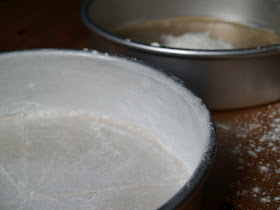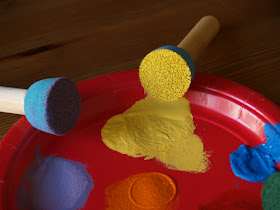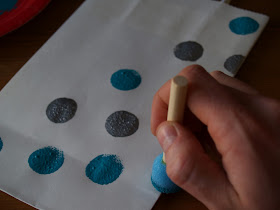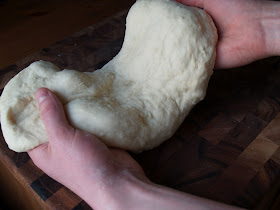Each year on his birthday, I let Aaron select a cake and ice cream of his choosing. I pile up my cookbooks, magazines, and various clippings and let him have his pick. I think it's a slightly overwhelming task and each year I can see he gets a bit nervous, hoping he makes the right decision (all the while knowing he can't really go that wrong). I love this process, because he inevitably chooses something that I wouldn't choose myself, or an unexpected recipe I've forgotten about or never used.
This year he chose an Old-Fashioned Banana Spice Cake from Birthday Cakes, a collection of recipes by Kathryn Kleinman and Carolyn Miller. He loves bananas and saw in the ingredient list that the cake calls for mace. I often find him rummaging through the spice rack seeking out the coveted scent of mace. I believe this is what sold him (even though it only calls for a pinch). I love how home-spun the cake looks, spilling over with heavenly custard, stuffed with bananas, and topped with freshly whipped cream.
This particular recipe comes from chef, restaurateur, and cookbook author, Bradley Ogden. Growing up, this was one of his favorite birthday cakes. I wouldn't say this cake screams birthday, but that's why I think it's a good choice. It's a departure from the sweet and overly frosted cakes (which, don't get me wrong, I deeply love) that are synonymous with birthdays. It's a nice change, not to mention absolutely delicious! We had a few friends over for cake and bubbly, and it was devoured in less than 30 minutes. Judging by the outcome, I would have to say Aaron made an excellent choice this year.
OLD-FASHIONED
BANANA SPICE CAKE
Adapted
from Bradley Ogden, Birthday Cakes
Ingredients:
For
the cake:
½ cup
(1 stick) unsalted butter, at room temperature
1½ cups
granulated sugar
2 large
eggs, room temperature
1 cup
mashed ripe bananas (2 to 3 bananas)
1 tsp.
vanilla extract
2 cups
cake flour
1 tsp.
baking soda
½ tsp.
salt
½ tsp.
ground cinnamon
1/8 tsp.
ground allspice
Pinch
of ground mace (or ground nutmeg)
½ cup
buttermilk well shaken, at room temperature
For
the filling:
1½ cups
whole milk
½ cup
granulated sugar
4 large
egg yolks
6 tbsp.
all-purpose flour, sifted
Pinch
of salt
2 tbsp.
unsalted butter
1½ tsp.
vanilla extract
1 or 2
tbsp. heavy cream or milk (optional)
5 to 6
bananas, peeled and sliced
Simple
syrup (see notes below)
For
the topping:
1 cup
cold heavy cream
3 tbsp.
confectioner's sugar, sifted
¼ tsp.
vanilla extract
Preheat
the oven to 350 degrees F. Evenly butter the sides and bottoms of two 8-inch
round cake pans. Cut two pieces of parchment to fit the bottoms of both pans.
Stick the parchment to the buttered pans and butter the parchment. Toss some
flour in the pans to evenly coat, knocking out any excess flour. Set aside.
Using
an electric mixer on medium speed, cream the butter and sugar together in a
large bowl for about 10 minutes or until light and fluffy. Beat in the eggs,
mashed banana, and vanilla extract. Sift the flour, baking soda, salt, and
spices together onto a large sheet of waxed paper. While stirring, funnel the
flour mixture into the banana mixture alternatively with the buttermilk.
Spoon
the cake batter into the prepared pans (if you have a kitchen scale, weigh the
batter and distribute it evenly between the two pans), and smooth the tops with
a spoon or rubber spatula. Bake for 25 to 30 minutes, or until a cake tester or
wooden toothpick inserted into the center comes out clean. Transfer the pans to
wire racks and let cool for about 10 minutes. Unmold the cakes onto the racks
and let cool completely before frosting.
While
the cakes bake, make the custard filling: In a 2-quart saucepan, heat the milk
over low heat until you see small bubbles beginning to form around the edges of
the pan (keep and eye on it and be careful not to boil). Remove from heat and
let it rest for a few minutes. Meanwhile, using an electric mixer, beat the
sugar and egg yolks together in a small bowl, until the sugar is incorporated
and the mixture is pale yellow in color, about 2 minutes. Slowly beat in the
flour and salt. Increase the mixer speed to medium and very slowly pour in the
hot milk.
Return
the mixture to the saucepan and cook over low heat, whisking constantly, about
3 to 4 minutes. As soon as the custard begins to thicken, remove the pan from
the heat and whisk it vigorously for a few seconds. Whisk in the butter and
vanilla. Transfer the custard to a small bowl and let cool for a few minutes.
Place a sheet of plastic wrap directly on the surface of the custard and
refrigerate until completely cool, about 1 to 2 hours or overnight.
To
assemble the cake, split each cake in half using a long serrated knife. If the
custard seems to thick to spread, thin it with a little cream or milk. Lightly
brush the first cake layer with simple syrup. Spread one-third of the custard
and evenly arrange one-third of the banana slices on top of the custard. Repeat
with the next two layers. Carefully top with the fourth layer. Place in the
refrigerator for about 30 minutes to allow the custard to firm up. Meanwhile,
place a small deep mixing-bowl and the whisk attachment to an electric mixer in
the freezer to chill.
Just
prior to serving (or about an hour before serving if you'd like to make it
ahead), make the topping. Remove the bowl and whisk attachment from the
freezer. Add the cream to the bowl and using an electric mixer, whip the cream
until soft peaks form. Beat in the sugar and vanilla. Using a rubber or cake
spatula, spread the whipped cream frosting over the top of the cake, creating a
design if desired.
Yield:
One 8-inch, 4-layer cake (serves 10 to 12)
Notes:
- To make the simple syrup, combine 1 cup of granulated sugar with 1 cup of water in a small saucepan. Heat until the sugar is completely dissolved. Let cool before placing in a clean jar or bottle and refrigerating. Brushing the cakes with simple syrup will keep them nice and moist and prevent them from drying out. It's especially important to do this in cakes that are not frosted and exposed on the sides, such as this one.
- Feel free to bake the cakes and make the custard the day before serving. Once cooled, place the cakes in gallon-sized zip-top bags or wrap with several sheets of plastic wrap. Cut and assemble the cakes the following day.






























































